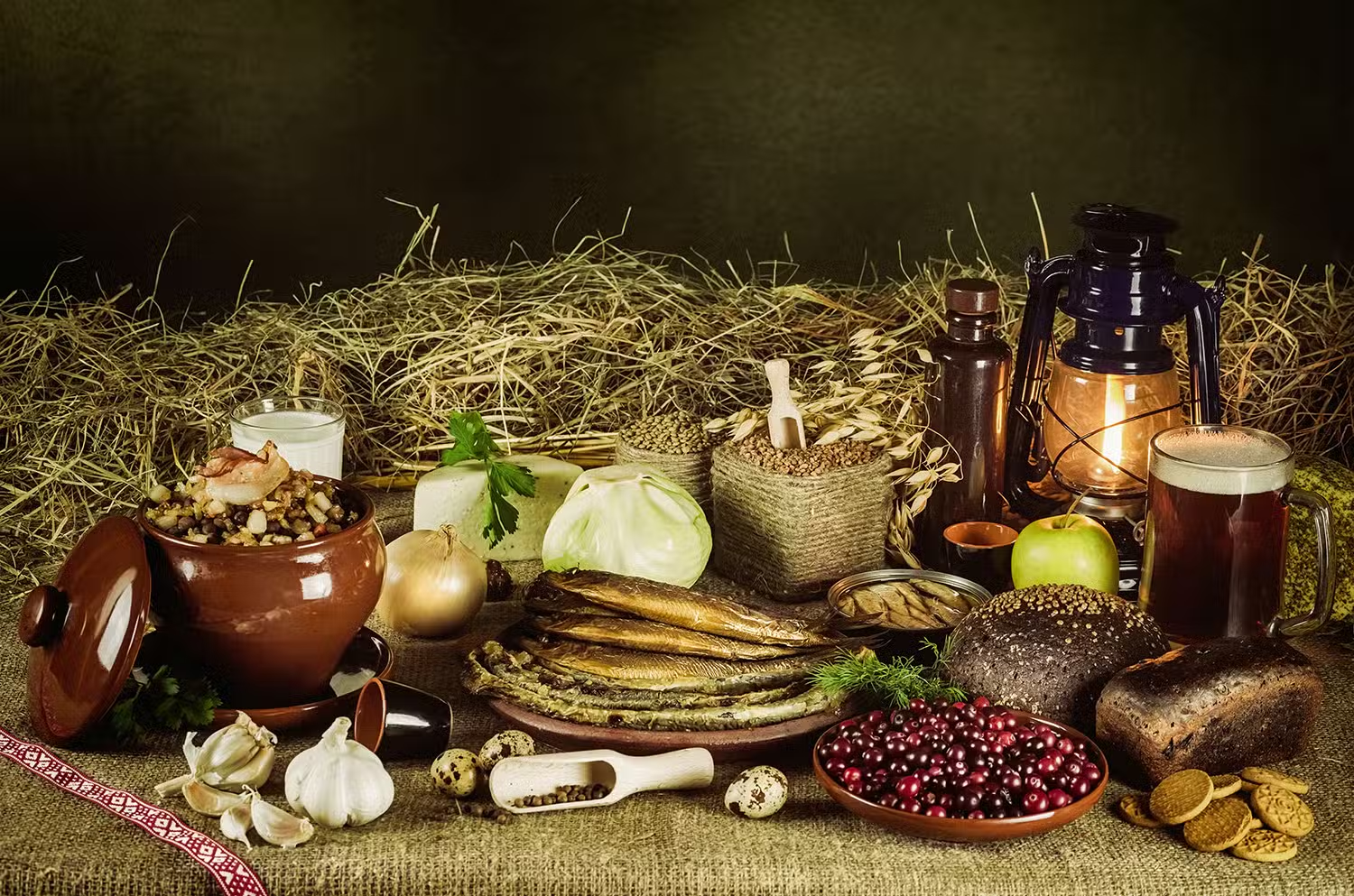Latvian cuisine shows strong influence from German, Scandinavian, and Slavic sources. It also has many fundamentally Latvian traditions that are often overlooked by outsiders but which are deeply cherished locally.
Latvian cuisine is heavy on pork, potatoes, fermented dairy, and pickled vegetables. Herring and lampreys from the Baltic Sea and local rivers provide delicacies that have historically been important protein sources. Forest products also abound: berries, honey, mushrooms, and even unique uses of birch and pine trees. Favored seasonings include garlic, dill, cumin, and poppy seeds.
Latvia has a strong brewing tradition that runs back to prehistory – with various drinks made from grains, berries, honey, and even flowers.
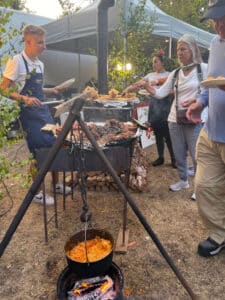
Celebratory Latvian meals are known for featuring several traditional dishes and being interspersed with song. Hiking and picnicking are considered national traditions. It is also worth pointing out that, although it is a small country, there are important regional dishes and regional variations on national dishes.
We have listed most entries in English translation. In most cases, the names are descriptive and can be translated directly with little or no loss of meaning. In these cases, we have also provided the Latvian translation at the end. For the few dishes where direct translation is not effective, they tend to be best known in English by their Latvian names and we have listed them as such. Information on the etymology appears at the end of the entry.
We have also added a small appendix of unique Lithuanian foods that are common in Latvia for reference.
Shaped by its waters, forests, and history, Latvia’s cuisine offers a surprisingly deep and nuanced experience. Join us as we traverse this flavorful landscape, one dish, and one word at a time.
Barley Porridge: (Main Dish; Side Dish) Al dente boiled barley groats are added to frying potatoes, onions, and speck (pork belly or bacon) and cooked until done. Served with sour cream, butter, dill, and/or green onions. Often eaten for breakfast by itself. (Bukstiņputra)
Beer: Beer traditions in Latvia run back to pagan times. Most Latvian brews today are pale lagers, but there is also a massive local craft beer movement that is building new and reviving old traditions, such as flavoring beers with herbs, berries, honey, and even pine needles. Look for these at the annual Riga Pours Craft Beer Festival, as well as Janus, Latvia’s national summer solstice festival, and other celebrations. (Alus)
Berries: The impressive array of berries found in Latvia’s forests have long been part of the Latvian diet. From blueberries (mellenes), cranberries (dzērvenes), wild strawberries (zemenes), cranberries (dzērvenes), and raspberries (aveņes) to the more unique sea buckthorn (smiltsērkšķi), lingonberries (brūklenes), black currant (upenes), red currant (jāņogas), cloudberries (lācenes), chokeberries (aronijas), and ashberries (pīlādžogas), they are eaten in jams, jellies, syrups, sauces, and desserts, pressed into compotes, infused into teas, and fermented into liquors, balsams, and wines. Fresh berries are a summer staple and often gathered straight from the forests even today. (Ogas)

Biezpiena plācenīši: (Main Dish, Dessert) Biezpiens is mixed with eggs, flour, sugar, and a pinch of salt, shaped into patties and fried into a breakfast favored by many Latvians. Typically served fresh and warm, accompanied by sour cream, jam, and/or fresh berries. These are essentially identitical to the Slavic dish known as syrniki. (lit: cottage cheese scone; see also: biezpiens)
Biezpienmaize: (Dessert) A dessert with a thin, cakey crust baked together with a biezpiens topping. Perhaps best translated as “bars” in English. (lit: cottage cheese bread; see also: plātsmaize)
Biezpiens: (Dairy Product) A type of strained cottage cheese, biezpiens is used in a range of foods from sweet cheese pancakes to the savory salted herring with boiled potatoes and cottage cheese. Mixed with sour cream, dill, parsley, cucumber and/or radish, it is often spread on black bread for breakfast. Latvian biezpiens tends to be tangy and relatively dry with distinct grains. (lit: thick milk)
Biezpiena sieriņš: (Dessert) Invented under the Soviets, these are now a Latvian tradition: a stick of compressed, sweetened biezpiens is coated in a thin layer of chocolate and sometimes filled with fruit jams, caramel, or vanilla cream. Most often store bought with the most popular Latvian brand being Kārums. (lit: cottage cheese cheese; most often rendered as “curd snack” by Latvians speaking English.)
Birch Sap: (Beverage) This slightly sweet, woody juice can be tapped and drunk straight from the tree or made into sweetened beverages, wines, and syrups. Another traditional forest product, this is often gathered by individual Latvians for personal use (legal so long as the tree is at least 40 cm in diameter). (Bērzu sula)
Black Balsam: (Spirit) Created in 1752 by a Riga pharmacist and made from herbs steeped in sweetened vodka and aged in oak barrels. Today a national treasure, its exact recipe and process is known to one master brewer and an apprentice. Tours are available of the original distillery, which is still in use. (Melnais balzams)

Black Bread: (Bread) Made from rye flour and long a national symbol of Latvia, black bread is served with most meals. Traditionally made with sourdough starter and flavored with caraway seeds, this super dense, tangy bread has a natural shelf life of up to three months if stored correctly. (Rupjmaize)
Blood Sausage: (Main Dish; Side Dish) Cooked barley or oats is mixed with fresh pig’s blood, chopped onions, and other seasonings, stuffed into pig intestines, and boiled until firm. Before serving, it is sliced, fried, and usually plated with lingonberry sauce, boiled potatoes, and sauerkraut. (Asinsdesa)
Buckwheat: A staple grain in Latvian cuisine, known for its nutty flavor and nutritional benefits, its groats are boiled until tender, often with a pinch of salt and/or butter. Often eaten straight as porridge, served as a side, used as a base for ragus, casseroles, or stuffings. Latvia’s buckwheat production is soaring as the country prioritizes food security and local sources for traditional ingredients. (Griķi)
Cabbage Soup: (Soup) A simple yet flavorful soup made with cabbage, potatoes, carrots, and sometimes smoked sausage or other meat. Seasoned with caraway seeds and dill and often served with sour cream. (Kāpostu zupa)
Cabbage Rolls: (Main Dish) Ground meat (often pork and/or beef) is mixed with rice and onions, wrapped in blanched cabbage leaves, stewed in tomato sauce, and fried. Served with sour cream and fresh dill. Of Jewish origin and common across central and eastern Europe, the tradition of frying them is largely unique to Latvia. (Kāpostu tīteņi)
Cumin: (Seasoning) Both seeds and leaves are used extensively in traditional Latvian dishes including rye bread, sauerkraut, and Jani cheese, as well as various soups, stews, and other dishes. (Kumīns)
Debesmanna: (Dessert) Semolina (cream of wheat) is cooked in sweetened fruit juice and later whisked until fluffy, creating a type of mousse. Cranberry juice is most traditional, although currants, or other tart berries can also be used. Served chilled, often with a drizzle of cream, whipped cream, or milk. (lit: manna from heaven)
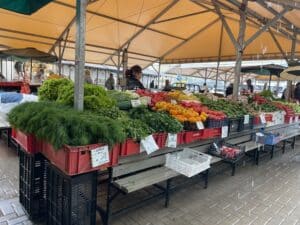
Dill: (Seasoning) An essential part of Latvia’s cuisine for millennia. Latvians themselves often joke about how much of the aromatic and slightly tangy herb they use, both fresh and dried, in soups, salads, pickling, and in dressing meat or potato dishes. (Dilles)
Farmer’s Breakfast: (Main Dish) Potatoes, onions, and pork (bacon, sausage, and/or smoked pork) is cooked together in a skillet. Eggs are often added towards the end, either scrambled into the mixture or fried and placed on top. Seasoned with salt, pepper, fresh dill, and/or green onion. (Zemnieku brokastis)
Fish Soup: (Soup) Nearly any of the fresh or saltwater fish common in Latvia, with pike, perch, or cod being most common, can be simmered with vegetables like potatoes, carrots, and onions seasoned with dill, parsley, bay leaves, or black peppercorns. Some variations include cream for richness or barley for additional texture. (Zivju zupa)
Garlic: (Ingredient) Grown there for centuries in Latvia, it is now perhaps the most used seasoning. Also used in folk remedies to boost immunity and fight colds. (Ķiploki)
Gingerbread: (Dessert) Long a Latvian holiday tradition, gingerbread can be crisp or soft cookies made from flour, sugar, honey, and a distinctive blend of warming spices such as cinnamon, ginger, pepper, cloves, nutmeg, cardamom, and coriander. (Piparkūkas)

Gray Peas: Similar to chickpeas, gray peas have a firm texture, nutty flavor, grayish-brown color, and are an absolute staple in Latvian cuisine. Used in stews, soups, salads, and cooked on their own for sides or even as a main dish. (Pelēkie zirņi)
Gray Peas and Speck: (Main Dish) Perhaps Latvia’s most iconic national dish and essential part of its Christmas Eve meal. Gray peas are mixed with fried speck (smoked pork belly or bacon), and onions. Also known as an everyday peasant dish – as even when everything else ran out, dried peas and cured pork could usually be procured. (Pelēkie zirņi ar speķi)
Herbal Teas: (Beverage) Another forest product, herbal teas are made from local peppermint (piparmētru tēja), meadowsweet (vīgriežu tēja), cowslip (gaiļbiksīšu tēja), linden (liepu tēja), fireweed (ugunspuķes tēja), St. John’s wort (asinszāļu tēja), and the leaves of many berry bushes. Commonly gathered and dried by individuals and essential to many folk remedies. (Zāļu tējas)
Herring: Abundant in the Baltic Sea, this oily, rich fish is commonly eaten throughout the region. Marinated herring (marinēta siļķe) is particularly popular in Latvia and often eaten with boiled potatoes and biezpiens (marinēta siļķe ar vārītiem kartupeļiem un biezpienu), one of the culture’s staple comfort foods. Also eaten on black bread with a variety of condiments. Smoked, salted, and baked herring are also popular. (Siļķe)
Honey: Gathered wild or farmed with traditional beekeeping practices developed by Latvians to support bees in their far-northern climate, honey is used as a sweetener and in folk medicine. Also brewed into mead, added to beer, or added to baked goods, teas, and desserts – perhaps most famously in honey cake. (Medus)
Honey cake: (Dessert) Flour, eggs, baking soda, and generous amounts of honey create each layer, interspersed with a filling made of sweetened sour cream or cream. Likely of Jewish origin, honey cake is often enjoyed for Christmas and Easter. Also widely available in restaurants, coffee shops, and bakeries. (Medus kūka)
Jāņi Cheese: (Dairy Product) Biezpiens, butter, eggs, and caraway seeds are cooked into a smooth paste which is wrapped in cheesecloth and allowed to dry, preferably outside. The result is a golden, rich, soft, fragrant cheese that is eaten in copious abundance, often with beer, for Latvia’s midsummer celebrations. (Jāņu siers)
Juniper Berries: (Seasoning) Small, hard, aromatic berries commonly used to flavor meat or pickled vegetables, giving a distinctive, slightly piney and peppery taste. Also said to help aid digestion and relieve respiratory issues. (Kadiķu ogas)
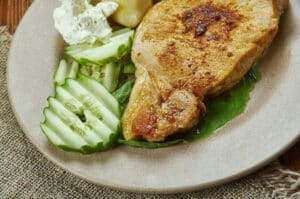
Karbonāde: (Main Dish) A breaded, pan-fried pork chop often served with stewed cabbage, pickles, sauerkraut, boiled potatoes, and/or mushroom sauce. A Latvian signature meal.
Kefir: (Dairy Product) This tangy probiotic is fermented by adding a symbiotic culture of bacteria and yeast to milk and left at room temperature for about 24 hours. The result can be drunk straight or mixed with fruits, herbs, and/or honey. Also used in cold soups, various baked goods, and marinades. (Kefīrs)
Kļockas: (Dessert) Essentially donuts served in cream sauce, these are heavily associated with the Latgale region. They are sometimes prepared with a biezpiens-based filling. Can be flat or round. The sauce ranges from boiled milk to warm sweet cream, sometimes with added sour cream and/or butter.
Kvas: (Beverage) Tangy and mildly sweet, this traditional Latvian beverage is made by soaking dry rye bread in water, adding sugar, honey, and/or berries and fermenting the mixture until slightly carbonated. Some mistakenly believe that kvas was introduced by the Soviets, but in fact the drink has been made in Latvia for hundreds of years.
Lampreys: A traditional delicacy, especially in Latvia’s coastal regions. Usually served smoked or boiled. The town of Carnikava, located near the mouth of the Gauja River, hosts an annual Lamprey Festival. (Nēģi)
Mead: (Beverage) Made by fermenting honey with water, sometimes with spices, fruits, berries, or herbs, this drink has long been associated with celebrations in Latvia. (Medus dzēriens; lit: honey drink)
Meatball Soup: (Soup) A comforting soup featuring small meatballs of pork and/or beef cooked in a broth with potatoes, carrots, onions, parsley, and/or dill. (Frikadeļu zupa)
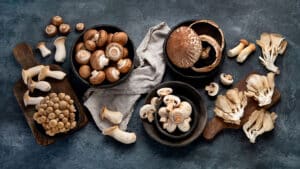
Mushrooms: Individual Latvians gather many mushrooms from the wide forests. From the popular porcini and chanterelle to the more gourmet wooley milk caps and parasols, mushrooms are part of many main dishes, as well as sauces and soups, especially when fried and mixed with cream. Can also be cooked or picked and eaten on their own as a side or appetizer. (Sēnes)
Pickling: (Food Preparation) Most northern cultures greatly value pickling for food preservation. Either vinegar or salt solutions can be used, often flavored with garlic, dill, and more. Latvians often pickle cucumbers, cabbage, beets, mushrooms, herring, garlic, tomatoes, and sometimes apples and pears. Do not be surprised to find sauerkraut and/or other pickles served with almost every meal. (Sālīšana)

Pine Trees: Little known to the world, but well-known in Latvia is that much of the pine tree is edible – and a good source of vitamin C, which is particularly valued in traditional northern cultures. Pine buds can be eaten straight from the tree in the spring to freshen the breath and awaken the senses. Pine needles can be boiled into tea or syrup to add pungent flavor to drinks, desserts, and sauces. Pine cones, which are mostly fiber, but still edible and still contain vitamin C, can be boiled and eaten straight or candied into preserves. Pine nuts, the most nutritious part of the tree, are gathered and eaten straight or as garnish on other dishes. (Priedes)
Plātsmaize: (Dessert) A dessert with a thin, cakey crust baked together with its fruit topping – often rhubarb, apple, or and/or berry. Perhaps best translated as “bars” in English. (lit: flatbread; see also: biezpiensmaize)
Pork: The favored meat in Latvia, most traditional or festive meals will include pork. Pork roast is very common for Christmas. Latvian cuisine uses pretty much every part of the pig including pork knuckle (cūkas stilbs), ears (auss), snout (šņukurītis), feet (kājas), and pig’s head stew (grudenis). (Cūkgaļa)
Pork Ragu: (Main Dish) Pork and potatoes, carrots, onions, and sometimes turnips or parsnips are cooked together. While there can be a sauce, generally the ingredients simply stew in their own juices. Cabbage is a common addition as are bay leaves, caraway seeds, and fresh or dried dill. Can be served over mashed potatoes or buckwheat. (Cūkgaļas sautējums)
Pork Jelly: (Side Dish) Pork trotters, hocks, and sometimes ears, are boiled with onions, carrots, bay leaves, and peppercorns for hours to create a rich, gelatinous broth. The meat is pulled, the strained broth poured over it and then chilled until set into a jelly. Once made principally with pork tongue, under the Soviets, it converged with kholodets, incorporating more meat from the bone. Served cold, accompanied by mustard, vinegar, or horseradish. Common at Christmas and New Year’s. (Aukstā gaļa; galerts)
Potatoes: Often called “second bread” in Latvia, potatoes are present at nearly every dinner there. Introduced in the late 17th century, potatoes grow well in the local climate and soil, and have proved reliable during long winters and regular calamities. Used in salads, casseroles, soups, stews, pies, potato pancakes, or simply boiled and served with butter and dill. (Kartupeļi)
Potato and Bean Sausage: (Main Dish; Side Dish) Mashed potatoes, cooked white or navy beans, and sautéed onions are mixed, stuffed into pig intestines, and either boiled or baked until firm. Before serving, it is sliced and fried, and usually served with pickles, sauerkraut, and sour cream. (Kartupeļu un pupu desa)

Potato Pancakes: (Main Dish; Side Dish) Grated raw potatoes, mixed with eggs, flour, salt, finely chopped onions, are fried in oil until crispy on both sides. Most often served with sour cream and lingonberry jam. (Kartupeļu pankūkas)
Pretzels: (Bread) Yeast-leavened dough made with flour, milk, butter, sugar, and eggs is baked, usually after being formed into a distinctive shape. A rich, soft bread long associated with weddings, name days, and other festive gatherings, many varieties exist such as a large circular version made for Easter, extra large versions with fillings or to be made into sandwiches, and gourmet dessert versions. (Kliņģeri)
Quince: Introduced in the late 1800s, quince is now a staple of local cuisine. Sweet and soft when cooked, this fruit has a taste between that of an apple and pear as well as a high pectin content, making it ideal for jams, jellies, and desserts. It is sometimes used to complement cheese and meat dishes, used in compotes and baked goods, and sometimes fermented or infused into liquors and brandies. (Cidonija)
Sauerkraut: (Side Dish) Shredded cabbage is fermented in open air with salt and often caraway seeds. Tangy and slightly sour, this healthy prebiotic accompanies most meat meals in Latvia and is often used in soups. (Skābēti kāposti)
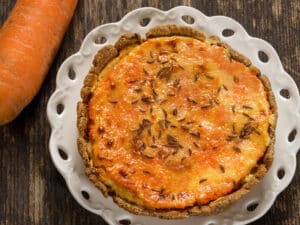
Sklandrausis: (Dessert) A creamy potato and carrot filling sometimes flavored with caraway seeds, sugar, or honey fills a rye shell in this distinctive tart that is often eaten cold with a glass of milk or tea. Its birthplace, the Kurzeme region, organizes a festival every year in its honor. (lit: smoothie)
Smoking: (Food Preparation) A traditional preservation method that imparts distinct flavors to food. In Latvia, lampreys, trout, herring, sprats, pork, bacon, and sausages are often smoked. (Kūpināšana)
Sorrel Soup: (Soup) Sorrel leaves, potatoes, and carrots are simmered into a tangy and refreshing soup often topped with a sliced hard-boiled egg, dill, and sour cream. (Skābeņu zupa)
Sour Milk: (Dairy Product) Fresh milk is left to ferment at room temperature, often with the addition of the remnants of the last batch of soured milk. The result is a thickened, tangy product that is often drunk on its own, used in sauces, soups, or baked goods, including as a way to produce sourdough starters. Also the starting stage to producing biezpiens. (Rūgušpiens)
Sour Cream: (Dairy Product) Put on just about everything and anything from soups to desserts, and often used in baking. (Skābais krējums)
Speķrauši: (Bread) Always crescent shaped and filled with bacon and often onion, these meat pies are considered a Latvian national staple and eaten for many holidays. (lit: bacon bread rolls)
Sprats: (Fish) Usually smoked and sold canned in oil, these fish are commonly eaten in Latvia on buttered rye bread slices. (Šprotes)
Tomato and Cucumber Salad: (Salad) Chopped tomatoes, cucumbers, and dill, dressed in sour cream. One of Latvia’s most common salads. (Tomātu un gurķu salāti)
Rasols: (Salad) Began as a German tradition of making a salad out of whatever one had on hand. Under the Soviets, the recipe converged with Olivier and is today usually diced boiled potatoes, eggs, carrots, and peas mixed with pickles and often apples. Ham, bologna, and/or herring can be added. Bound together with mayonnaise, rasols is a holiday staple, but is either loved or hated – and sometimes derided as too “Soviet.”

Rupjmaizes Kārtojums: (Dessert) Crushed, stale rye bread is layered with sweet whipped cream and/or cottage cheese as well as fruit preserves and/or fresh berries to create a sort of parfait or trifle. Local lingonberries or cranberries are most traditional. The dessert is then chilled to allow the flavors to meld together. Regarded as distinctly Latvian, this dessert marks many celebrations. (lit: black bread arrangement)
Rupjmaizes Zupa: (Dessert) Stale black bread is reconstituted in water and simmered with dried fruits and sometimes sugar, honey, nuts, and/or flavorings like cinnamon, nutmeg, and/or lemon zest. It is then blended until smooth and served chilled, often topped with whipped or sour cream. Regarded as distinctly Latvian, this dessert marks many celebrations. (lit: black bread soup)
Veltnīši: (Main Dish) Sliced beef or pork is rolled around a filling that can vary widely – possibly involving cheese, bacon, prunes, carrots, pickles, mushrooms, and/or various herbs. Marinated in sweet cream, they are then baked and served together with the cream. Often associated with Christmas dinners. (Veltnīši)
Appendix of Lithuanian Foods
Latvian and Lithuanian cuisines hold many dishes in common. Further, many of the iconic dishes that most define their individual cuisines can be found and enjoyed in each other’s countries.As this is a resource meant for foreign students who will likely be visiting the region for the first time, we are including these entries for unique and highly recognizable Lithuanian foods here so that they can be identified properly by students encountering them for the first time. We hope to supply a full resource for Lithuania at a later date.

Cepelinai: (Main Dish) Lithuania’s national dumpling features a large, football-shaped outer shell made of mashed and grated potatoes. Mixing the two increases the starch content and allows them to gain a pasta-like consistency when cooked. This is wrapped around ground pork and onions and topped with sour cream, butter, bacon, and/or pork drippings. (it: zeppelins; they resemble blimps)
Cold Soup: (Soup) Kefir or sour milk is mixed together with beets, cucumbers, and dill, poured over boiled potatoes, and usually topped with half a boiled egg. It is a summer favorite, with an almost cult following in the Baltics. Lithuania hosts a massive festival every summer to celebrate the culinary gem. (Aukstā zupa)
Fried Bread: (Bread) Dark rye bread, a staple in Lithuanian cuisine, is cut into strips and fried in oil or butter, seasoned with salt and garlic, and served with a cheese or garlic dip or tossed with cheese, garlic, and/or mayonnaise to create a gooey, crunchy snack that pairs exceptionally well with beer. (Kepta duona)

Šakotis: (Dessert) Dough is applied to a turning spit in an oven or over an open fire. Lithuania’s tradition dates back to at least the 15th century and was likely borrowed from German or Polish recipes. Traditionally served at weddings, holidays, and special occasions, but now also mass-produced and sold at grocery stores and tourist stands as Lithuania’s national treat. (lit: tree cake; they are shaped like a pine tree)
Skruzdėlynas: (Dessert) Thin, crisp, fried dough is piled and stuck together with a honey and sour cream glaze. Sometimes sprinkled with poppy seeds, nuts, dried fruits, or candies. (lit: ant hill cake; they are conical and semi-chaotic in appearance)
You’ll Also Love
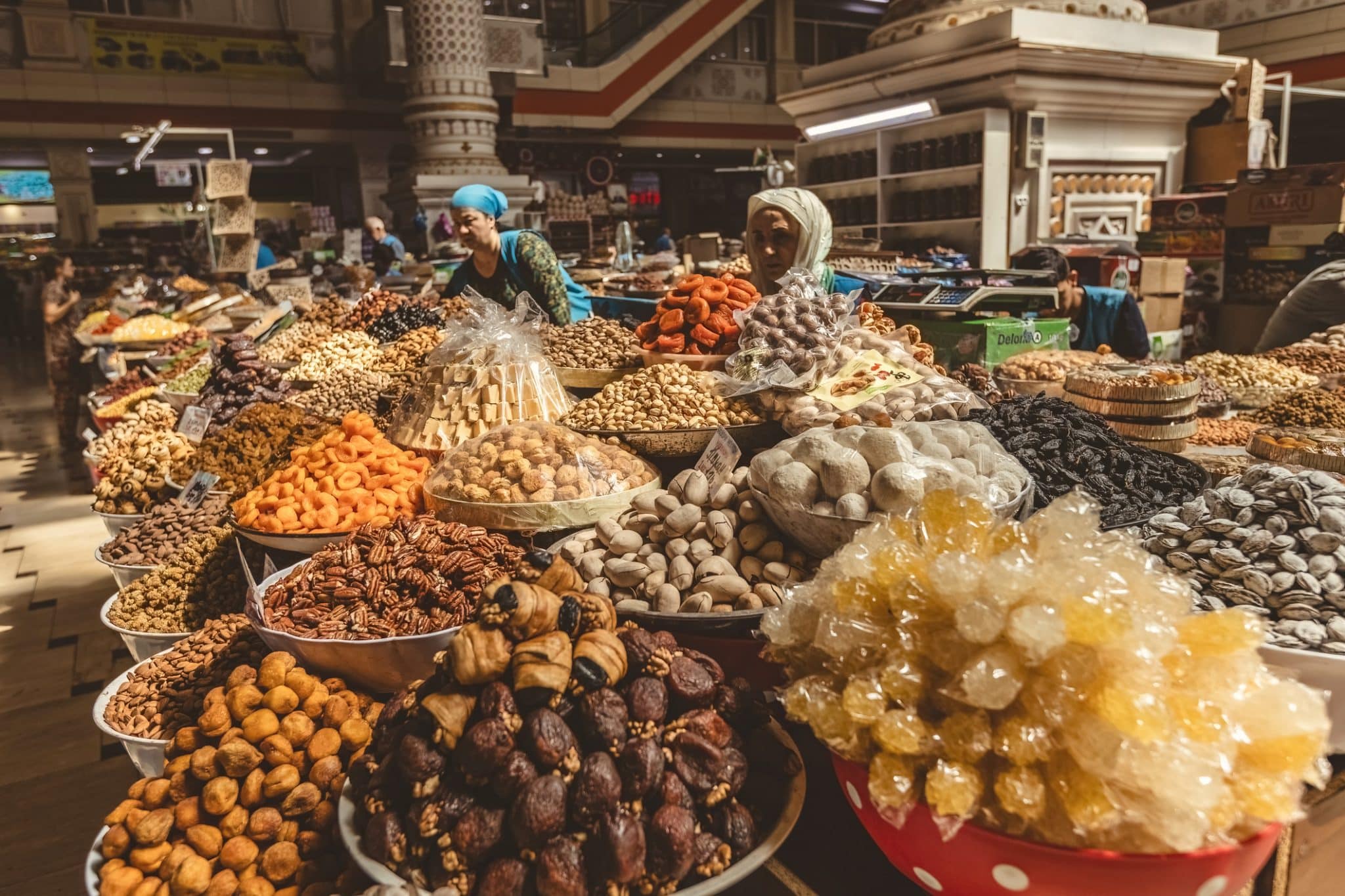
The Tajik Food Dictionary
Tajik cuisine draws influences from Persian, Turkic, and Afghan culinary traditions, as well as from the broader Central Asian steppe culture. Many dishes are held in common with Uzbekistan in particular. Of all the countries formerly a part of the Russian Empire and USSR, Tajikistan’s cuisine shows the least Russian influence. The Tajik diet heavily […]
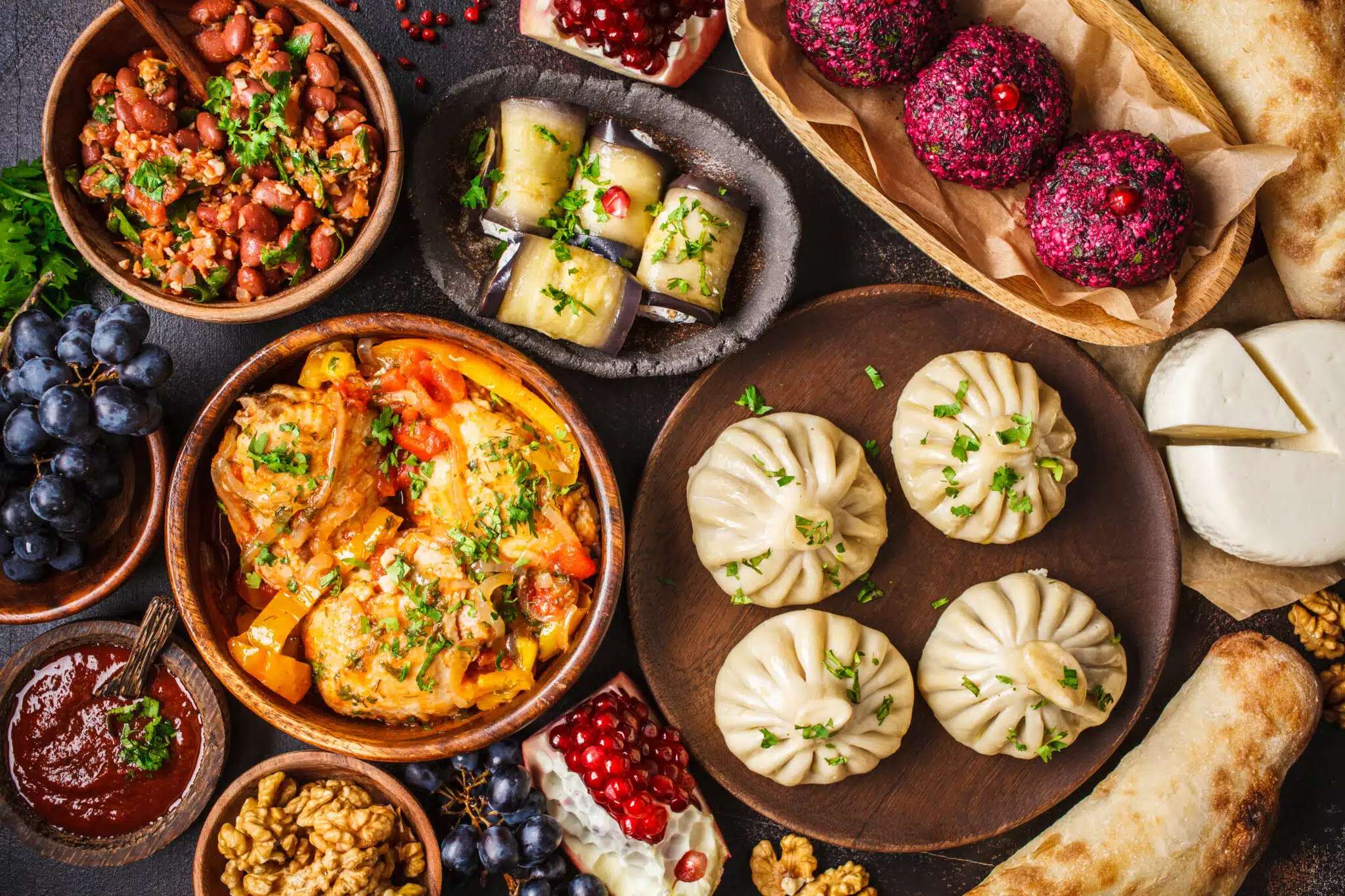
Dictionary of Georgian Food
The following dictionary is devoted to Georgian cuisine. Known for its rich flavors, diverse ingredients, and unique culinary techniques, Georgian food becomes a favorite of nearly all who try it. It is also surprisingly healthy and, overall, vegetarian-friendly. Our curated entries below outline not only well-known favorites like khachapuri, but also lesser-known desserts, a selection […]
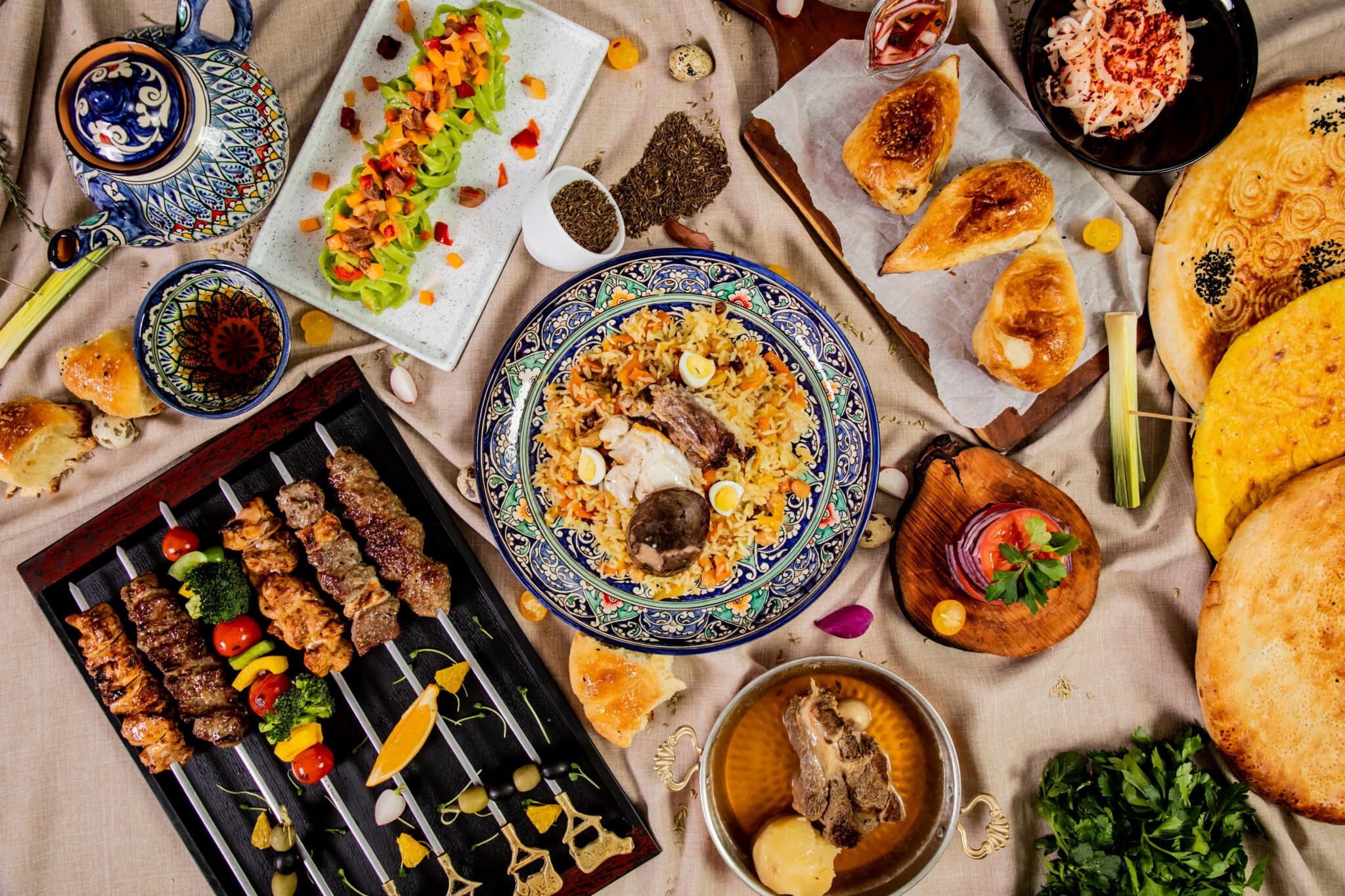
Dictionary of Uzbek Food
Uzbek cuisine is steeped in the rich history and diverse influences of Central Asia. Uzbek food is a distinctive branch of the broader Turkic culinary family, enriched by Persian influence as well as by the hearty foods of Eurasia’s nomadic cultures. Slavic influence comes from Uzbekistan’s time as a part of the Russian and Soviet […]
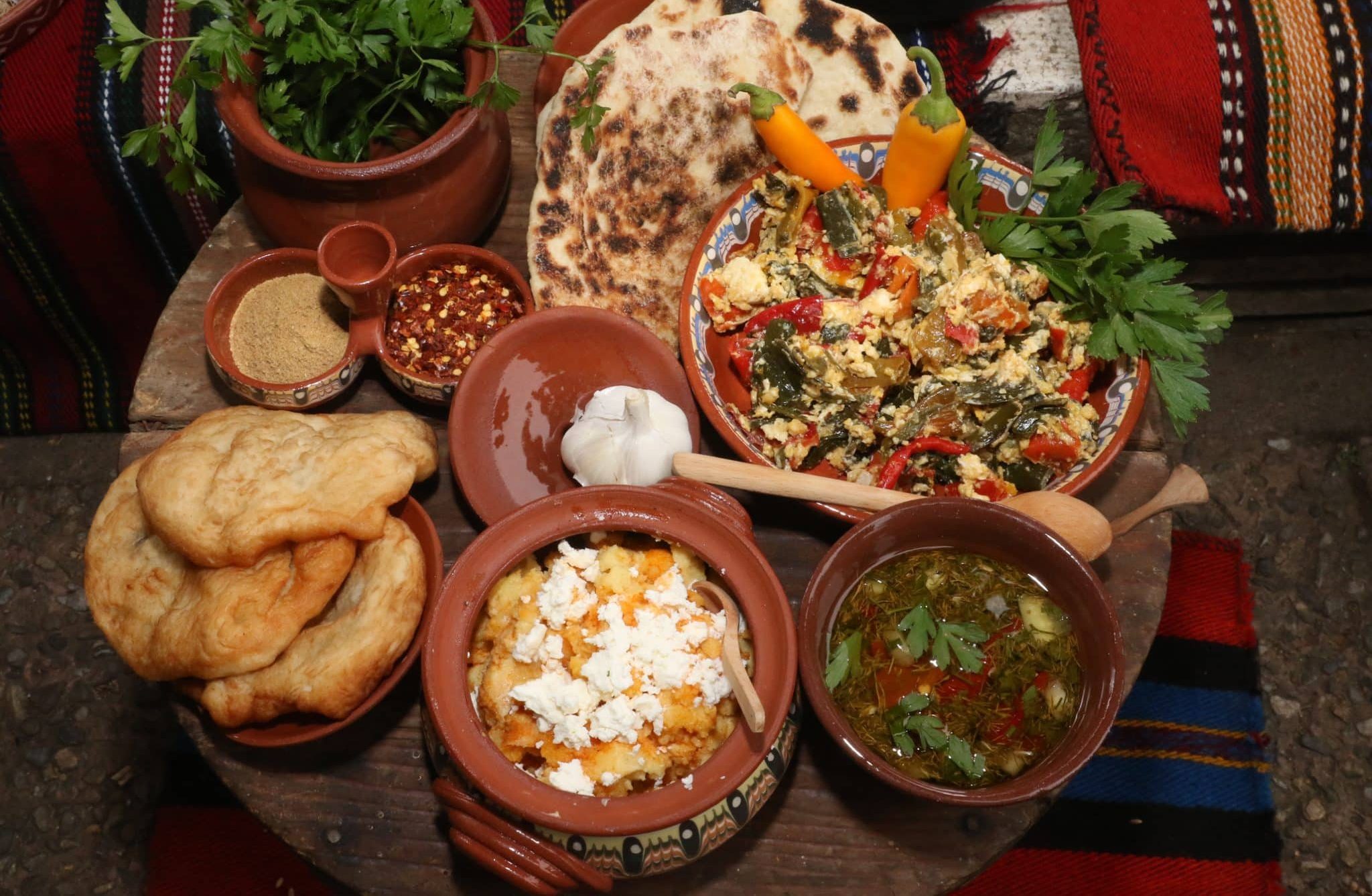
The Bulgarian Food Dictionary
Bulgaria’s earliest inhabitants were the Thracians. Originally nomadic herders, they settled in Bulgaria’s fertile, well-watered lands. There, they cultivated wheat, barley, and grapes, raised sheep, horses, and goats, and collected honey. Later, the arrival of the Slavs and Proto-Bulgarians in the Balkans further enriched the local culture and diet. Notable examples include fermented dairy and […]

The Turkish Food Dictionary
Turkish food balances hearty, aromatic flavors with simplicity and seasonal ingredients. Proteins typically come from lamb, beef, and chicken—pork is not traditionally consumed for religious reasons—while seafood is more common along the Aegean and Black Sea coasts. Yogurt, legumes like lentils and chickpeas, and eggs also play major roles in providing protein across the country. […]

